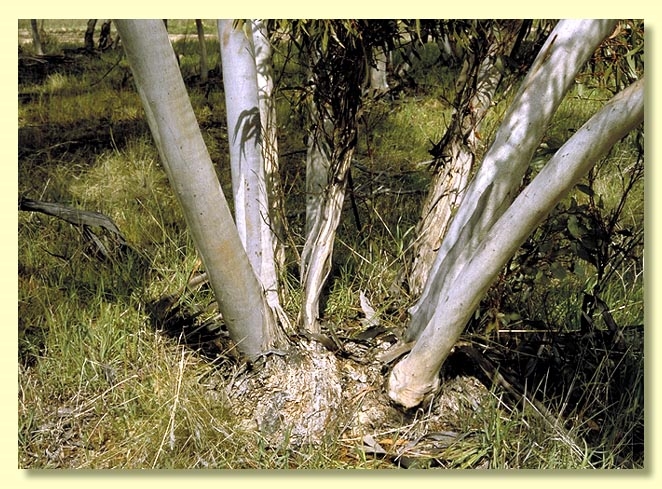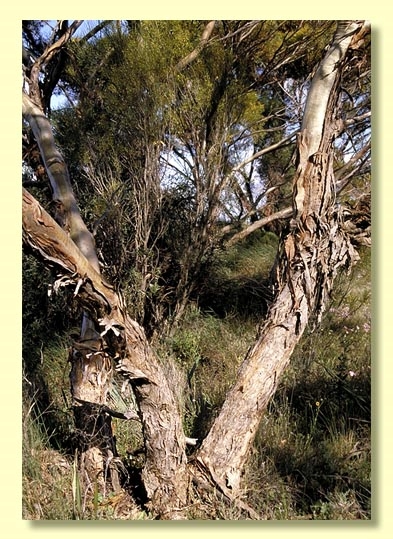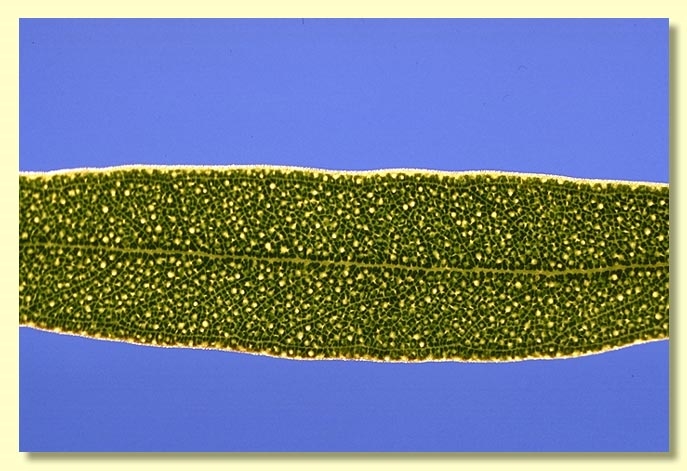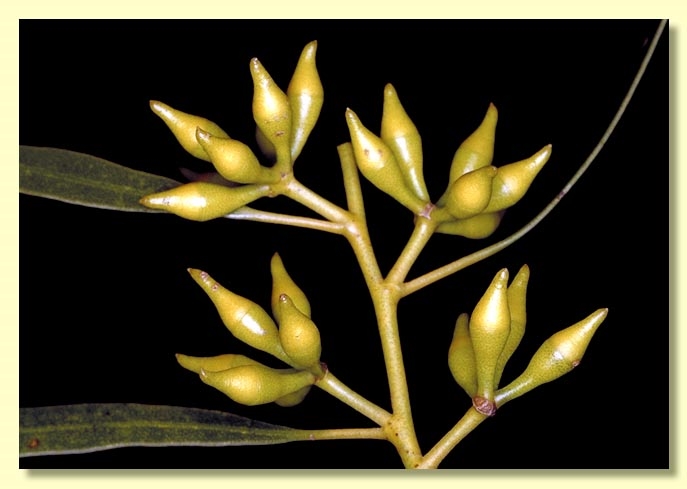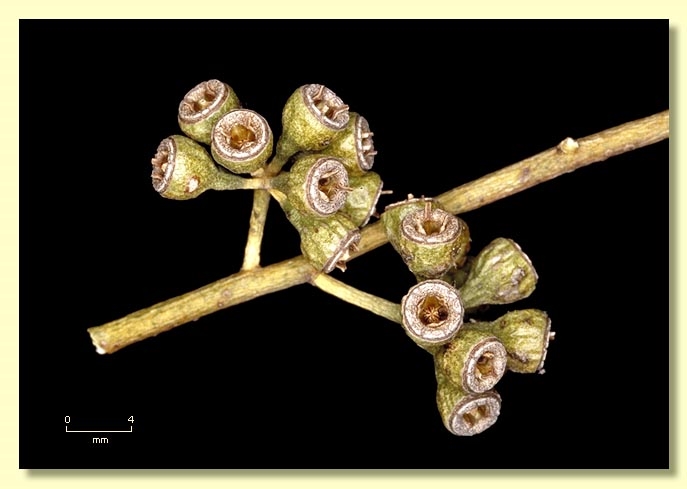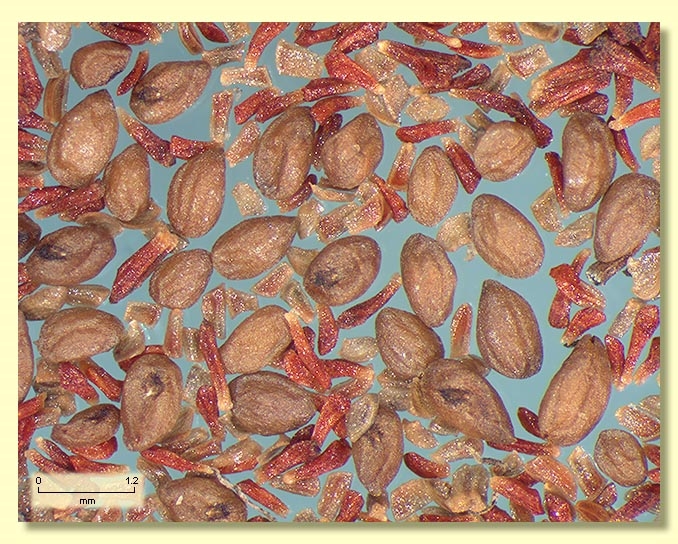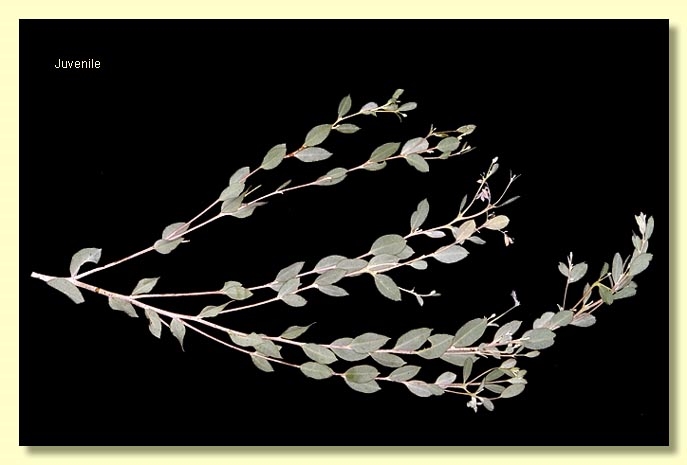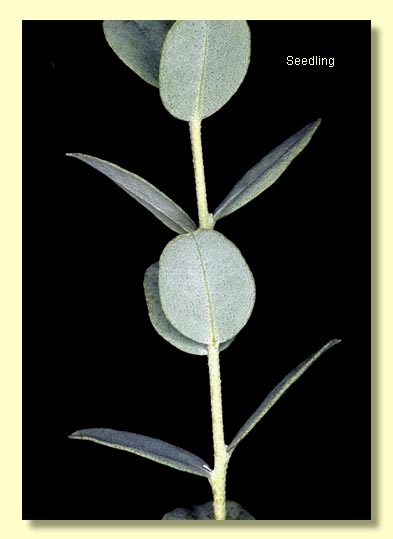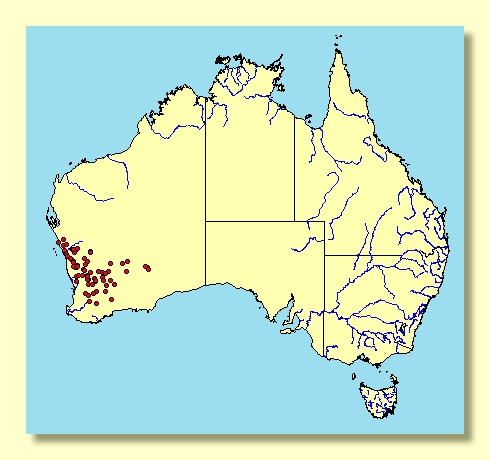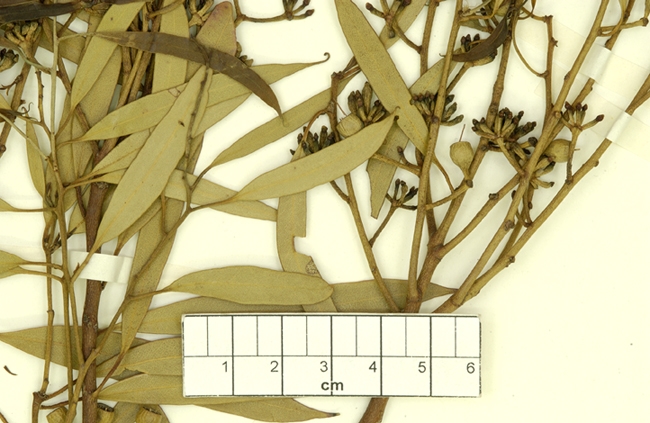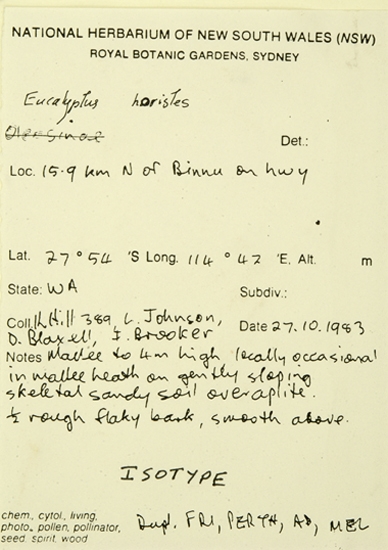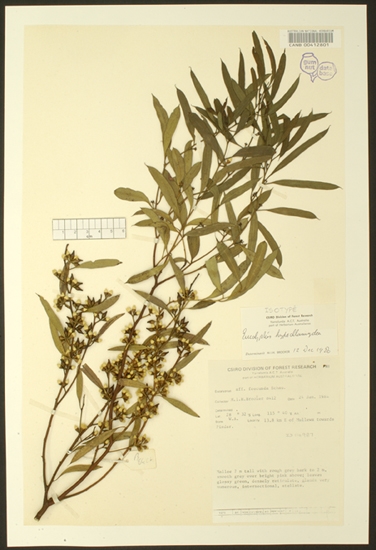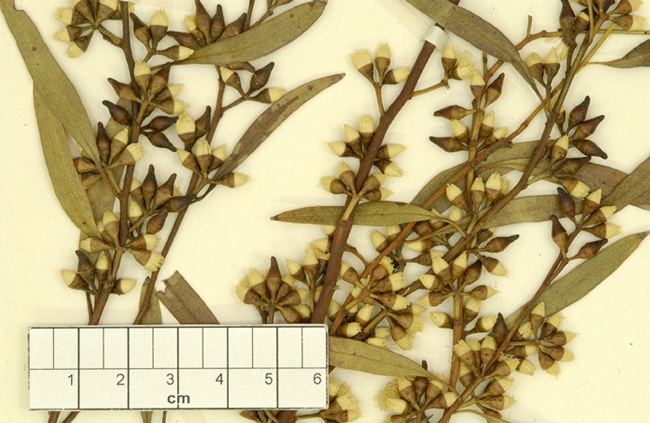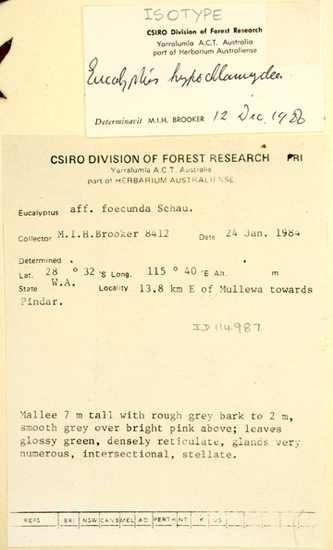Eucalyptus | Symphyomyrtus | Bisectae | Destitutae | Poranthera
Euclid - Online edition
Eucalyptus horistes
[The names Eucalyptus horistes L.A.S.Johnson & K.D.Hill and E. hypochlamydea Brooker are now regarded as representing the same species. The name E. horistes was first published to represent a different taxon, namely the taxon that is now called E. kochii subsp. borealis. The type specimen selected to represent the name E. horistes was misidentified and is now regarded as being identical to the type specimen of E. hypochlamydea Brooker. Under the International Rules of Botanical Nomenclature the name E. horistes takes priority as it was published five months earlier than the name E. hypochlamydea and thus the latter name is a synonym.]
Bark rough over part or all of trunk, firmly fibrous at base then semi-persistent ribbons above, scruffy, grey-brown, or smooth throughout, grey-green, and grey-brown.
Branchlets lacking oil glands in the pith.
Juvenile growth (coppice or field seedlings to 50 cm): stems rounded in cross-section, glaucous, often warty; juvenile leaves opposite at lowest nodes, sessile, orbicular to cordate and then elliptic, becoming shortly petiolate, alternate and narrowly elliptic when ca 0.3–0.7 m tall, 1–4.5 cm long, 0.8–3 cm wide, bases amplexicaul to rounded, margins entire to subcrenulate, glaucous weathering to grey-green.
Adult leaves alternate, petioles 0.4–1.5 cm long; blade narrowly lanceolate-elliptic, 4.5–9.5(11.5) cm long, 0.4–1.5 cm wide, base tapering to petiole, margin entire, apex finely pointed, glossy, green, side-veins greater than 45° to midrib, reticulation usually dense, intramarginal vein present, oil glands numerous, large, intersectional.
Inflorescence axillary unbranched, peduncles rounded, 0.2–1.3 cm long, buds 7, 9, 11 or 13 per umbel, pedicellate (pedicels 0.1–0.4 cm long). Mature buds ovoid to fusiform (0.5–1 cm long, 0.2–0.4 cm wide), scar present, operculum usually beaked (0.3–0.5 cm long), stamens inflexed (a few may be irregularly flexed), anthers cuneate-cuboid, adnate to filament apex (rigidly basifixed), dehiscing by sub-terminal pores, a few of the innermost stamens imperfectly formed, style long and straight, stigma tapered to blunt, locules 3 or 4, the placentae each with 4 vertical rows of ovules. Flowers creamy white.
Fruit pedicellate, rarely sessile (pedicels 0–0.4 cm long), shortly cylindrical to truncate-globose, 0.3–0.7 cm long, (0.3)0.4–0.6 cm wide, disc pale, descending, valves 3 or 4, near rim level.
Seeds brown or grey-brown, 1–2 mm long, flattened-ovoid or pointed at one end, dorsal surface sometimes longitudinally furrowed, surface smooth, hilum ventral.
Cultivated seedlings (measured at node 10): cotyledons Y-shaped (bisected); stems ± rounded in cross-section, glaucous, very warty; leaves sessile, opposite for ca 12 to 25 or more nodes before becoming sub-opposite to alternate, cordate to orbicular, 1.2–3 cm long, 0.8–3 cm wide, amplexicaul or the base rounded, apex rounded to emarginate or pointed, glaucous on both surfaces or grey-green above and glaucous below, undersurface is roughened by small warts similar to those on stem.
Flowering has been recorded in January, July and December.
A mallee or tree endemic to Western Australia occurring on sandy soils in the wheatbelt from Murchison River in the north southwards to Wagin and east into the goldfields to Leonora and Norseman and as far east as Ponton Creek in the Great Victoria Desert.
As treated here E. horistes is characterised by beaked buds and by seedlings that are glaucous with warty stems and orbicular to cordate sessile amplexicaul leaves opposite for many nodes. Typically the bark is rough over part of the trunk decorticating in coarse ribbons such that the stems look scruffy. From Three Springs south to Wagin and east to Bullfinch and Hyden smooth-barked or almost smooth-barked plants commonly occur. Herbarium specimens distributed with the unpublished name "E. stanbergiana" (e.g. Hill 696, 2198, 2218, 2219) from east of Norseman are also included here. These are variously noted to be smooth or partly rough-barked mallees or small trees.
Eucalyptus horistes belongs in Eucalyptus subgenus Symphyomyrtus section Bisectae subsection Destitutae because the buds have two opercula, cotyledons are Y-shaped and branchlets lack oil glands in the pith. Within this subsection E. horistes belongs to a group of about 16 species, series Porantherae, that are further characterised by having anthers completely adnate to the staminal filaments, strongly inflexed stamens, densely reticulate leaves with intersectional oil glands and by the fruit with a distinct thick rim that includes a whitish descending disc. The small, glossy leaves of species in series Porantherae may result in confusion with species in series Heterostemones; however, the fruit alone usually distinguish the series. The fruit of series Heterostemones are thin-rimmed.
Within its geographic range E. horistes is most likely to be confused with three species on the basis of buds, fruit and juveniles leaves—E. salicola, E. fruticosa, E. albida. It differs from these as follows: E. salicola is a smooth, often powder-barked tree of similar general appearance to salmon gum and is always near salt lakes; E. fruticosa is a rough-barked mallee always with some retained juvenile leaves amongst its otherwise adult crown; E. albida is a smooth-barked mallee with extremely glaucous non-warty but similarly shaped juveniles and always has blunt buds with a twisted style—E. horistes rarely shows this style character—and hemisperical-obconical fruit.
To the east of the range of E. horistes is another related species, E. leptophylla. That species is a smooth-barked mallee with buds having bluntly conical opercula and sessile, elliptic-oblong glaucous to grey-green juvenile leaves, and it occurs east from the central Great Victoria Desert to central New South Wales and western Victoria.
Other species related to E. horistes and bearing similar buds and fruit differ manifestly in having juvenile leaves much longer than wide.


